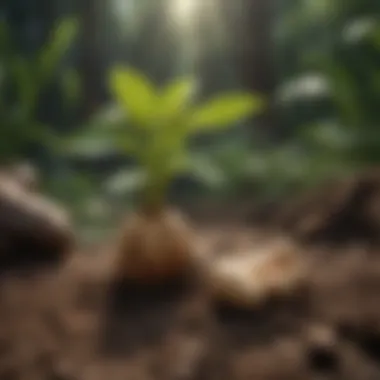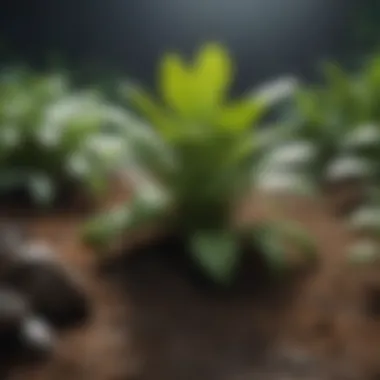How to Plant Ginger Root: Essential Gardening Techniques


Intro
Growing ginger root is a rewarding endeavor that offers not only the pleasure of nurturing a unique plant but also the benefits of its use in culinary and medicinal applications. Understanding how to properly plant and care for ginger can significantly enhance your success as a gardener, regardless of experience level. Ginger is an intriguing plant known for its aromatic rhizome, easily recognizable and cherished in kitchens worldwide.
Before delving into the planting process, it is vital to understand the conditions and requirements for ginger cultivation. This guide provides a thorough overview of selecting the right ginger root, assessing soil quality, and creating an ideal environment for growth. The following sections will equip you with practical insights that ensure your ginger thrives. Moreover, it will address common challenges you might confront during cultivation, enhancing your ability to produce robust ginger plants.
Plant Selection
Ginger is generally grown from rhizomes rather than seeds. When selecting ginger to plant, focus on specific criteria:
- Look for plump and healthy rhizomes with well-developed buds.
- Choose varieties such as Juvenile Ginger for early harvest and Mature Ginger for a stronger flavor.
- Avoid rhizomes that exhibit signs of decay or mold.
Purchasing locally or from reputable sources often ensures the quality of rhizomes. If possible, seek out organic options to avoid exposure to harmful chemicals.
Soil Preparation
Ginger thrives in well-draining, nutrient-rich soil. Preparing the soil is a critical process, requiring several steps:
- Choose the right location: Aim for a spot that receives partial sunlight, avoiding direct exposure to harsh midday sun.
- Check soil pH: Ginger prefers a slightly acidic to neutral pH (around 6.0 to 6.8).
- Incorporate organic matter: Adding compost or aged manure to the soil promotes fertility and moisture retention.
- Ensure proper drainage: Raised beds or pots with drainage holes work well to prevent waterlogging.
Planting Techniques
Once you have selected the ginger rhizome and prepared the soil, you can proceed with planting:
- Cut the rhizome into sections, ensuring each piece has at least one bud.
- Plant the sections about 2 inches deep, with buds facing upward and space them around 12 inches apart to allow for growth.
- Water lightly after planting to settle the soil, but do not overwater.
Maintenance Tips
Caring for ginger requires consistent attention to a few essential aspects:
- Watering: Ginger prefers consistently moist soil, so check regularly and water when the top inch feels dry.
- Fertilizing: Use a balanced fertilizer every 4-6 weeks during the growing season to support healthy growth.
- Weeding: Keep the area free of weeds that can compete for nutrients and water.
- Pest Management: Monitor for signs of pests and treat them promptly to prevent damage.
Regular maintenance plays a vital role in the success of your ginger plant.
Prelims to Ginger Cultivation
Ginger cultivation holds substantial significance for both personal gardens and commercial farming. With its myriad of health benefits and culinary uses, ginger is more than a spice; it is a highly valued plant. Addressing the essentials of growing ginger enables individuals to appreciate not only the plant's resilience but also its requirements, which often differ from more common vegetables and herbs.
Understanding the Ginger Plant
The ginger plant, scientifically known as Zingiber officinale, belongs to the family Zingiberaceae. This perennial plant is characterized by its green, tall stalks and narrow leaves. Its root system is composed of rhizomes, which are the edible parts we recognize as ginger. These rhizomes are typically harvested and used in cooking or for medicinal purposes. The growing process requires a warm, humid climate and well-draining soil to thrive, making it essential to understand these conditions before planting.
The ginger plant does not produce flowers in typical garden conditions, focusing more energy on developing its underground structures. Due to this, gardeners often overlook its growth above ground. However, recognizing the growth stages and needs of the ginger plant aids in providing suitable care.
Benefits of Growing Ginger
Cultivating ginger can be rewarding for various reasons:
- Health Benefits: Ginger is celebrated for its anti-inflammatory properties and is commonly used to alleviate digestive issues, nausea, and even sore throats. This makes it a valuable addition to any kitchen or medicinal garden.
- Culinary Uses: Beyond its health benefits, ginger is an essential ingredient in numerous global cuisines, enhancing flavors in both sweet and savory dishes.
- Economic Potential: For those considering commercial farming, ginger offers a lucrative market, especially with the growing trend towards organic produce. The increasing demand for natural remedies also adds to its value.
- Gardening Skills: Growing ginger can sharpen gardening skills, as it requires specific conditions and care. This cultivates a deeper understanding of plant biology and maintenance strategies.
In summary, understanding ginger cultivation opens doors to enhanced culinary experiences, increased health benefits, and potential financial gains. It provides a practical lesson in the art of gardening while contributing to overall wellbeing.
Selecting Ginger Roots for Planting
Choosing the right ginger roots for planting is crucial in achieving healthy and robust ginger plants. Healthy rhizomes set the foundation for growth and development. A good selection can lead to better yields and improve the overall quality of the ginger produced. When considering this topic, one must look at several factors that affect the quality and viability of ginger rhizomes.
Identifying Quality Ginger Rhizomes
Quality ginger rhizomes are essential for successful cultivation. When selecting rhizomes, look for those that are plump and firm. They should have a smooth skin and no signs of decay or damage. Here are some key points to consider when identifying quality ginger:
- Size: Choose larger rhizomes as they tend to establish better.
- Eyes: Look for rhizomes with visible growth buds or 'eyes.' The more eyes present, the more potential for sprouting when planted.
- Skin: The skin color should be light tan or yellow; avoid dark or shriveled specimens as they may be old and not conducive to growth.


Additionally, checking for any spots or mold can also indicate poor quality. The absence of any foul odors is another good sign that the rhizome is fresh.
Choosing Organic vs.
Conventional Ginger
Deciding between organic and conventional ginger for planting is significant. Organic ginger is grown without synthetic pesticides or fertilizers, promoting healthier soils and biodiversity. In contrast, conventional ginger may involve the use of chemicals which can impact the surrounding environment.
Pros of Organic Ginger:
- Healthier Consumption: Minimizes chemical residues in the end product.
- Sustainability: Better for soil health and ecosystems.
- Community Support: Often sourced from local farmers, promoting local economies.
Cons of Organic Ginger:
- Cost: Typically more expensive than conventional ginger.
- Availability: May not be as readily available in all regions.
Pros of Conventional Ginger:
- Yield: Often provides higher yields due to the use of fertilizers and pesticides.
- Cost-Effective: Usually cheaper than organic options.
Cons of Conventional Ginger:
- Environmental Impact: Potential negative effects on soil and local wildlife.
- Chemical Usage: Concerns over pesticide residues.
Ultimately, the choice between organic and conventional depends on personal values and local availability. Whichever you choose, proper selection will enhance the success of your ginger cultivation.
Preparing for Planting
Preparing for planting ginger root is a critical phase that lays the foundation for a successful growing season. Understanding the specific needs of ginger plants helps ensure a thriving crop. Proper preparation includes knowing the ideal soil conditions, selecting an appropriate location, and ensuring all necessary resources are at hand. Each of these elements contributes to the overall health and yield of the plants, making it essential for both novice and experienced growers.
Soil Requirements for Ginger
Optimal Soil pH
The soil pH is a key factor influencing ginger growth. Ginger prefers a slightly acidic to neutral pH range, ideally between 5.5 and 6.5. This pH level not only promotes nutrient absorption but also supports the growth of beneficial microorganisms. The key characteristic of this range is its ability to optimize the availability of essential nutrients such as nitrogen, phosphorus, and potassium, critical for root development.
Maintaining suitable soil pH is a beneficial choice in this article. The unique feature of optimal pH levels is their influence on both plant vigor and crop yield. However, if the pH deviates significantly from this range, it can lead to nutrient deficiencies and poor plant health. Regular soil testing can help maintain optimal conditions.
Nutrient-Rich Additives
Nutrient-rich additives play an essential role in preparing the soil for ginger planting. Adding organic materials such as compost or well-rotted manure improves soil structure and fertility. These additives increase the soil's ability to retain moisture and nutrients, which is beneficial for ginger's growth requirements. Nutrient-rich soil is key to producing healthy ginger plants that can withstand environmental stress.
The main advantage of using these additives is their ability to enrich the soil over time. As these materials decompose, they release nutrients gradually, ensuring that plants have access to essential resources throughout their growth cycle. Moreover, organic amendments foster a diverse soil ecosystem, which enhances overall soil health. However, one consideration to keep in mind is to avoid excessive application, which can lead to nutrient imbalances.
Choosing the Right Location
Sunlight Requirements
Sunlight is fundamental for ginger plants. They thrive in partial shade, receiving indirect light for at least 4 to 6 hours each day. This condition helps prevent sunburn on the leaves while still allowing for photosynthesis to occur efficiently. The key characteristic of this sunlight requirement is its impact on both growth rate and flavor development.
Selecting a location that meets these requirements provides optimal conditions for ginger's growth. The unique feature of this setting is that it allows for the balance of light and shade, promoting healthy, robust plants. However, too much shade can limit growth, making it essential to find the right balance.
Climate Considerations
The climate in which ginger is grown significantly influences its growth and yield. Ginger thrives best in warm, humid climates with temperatures ranging from 70°F to 90°F. This specific condition contributes to maximizing growth rates and enhancing flavor. Understanding climate considerations helps growers select the best planting time and variety suited to their local environment.
One key advantage of warm climates is the reduced risk of frost, which can damage tender ginger rhizomes. Additionally, the ideal humidity levels enhance moisture retention in the soil, benefiting the plants. However, extreme temperature fluctuations can stress the plants, so it's essential to monitor local conditions and adapt as necessary.
Preparing for planting involves understanding the role of soil pH, nutrient-rich additives, sunlight, and climate in securing a prosperous yield.
Step-by-Step Guide to Planting Ginger
Planting ginger root involves a sequence of careful steps to ensure successful growth. This section outlines necessary techniques that will serve as a foundation for both new and experienced gardeners. Following a well-defined process reduces the likelihood of errors, allowing for a better yield of this valuable crop.


Preparing the Ginger Rhizomes
Cutting and Drying
Cutting and drying the ginger rhizomes is an essential step before planting. The primary goal here is to prepare the rhizomes for optimal growth conditions. The process typically involves using healthy roots that are firm and plump, ensuring they are of high quality.
- Cutting: Each ginger rhizome should ideally have at least one eye, which is where the plant will sprout. When cutting, ensure the tools are clean to avoid introducing diseases.
- Drying: After cutting, the pieces should be left to dry for about 24 hours. This helps to form a callus over the cut area, preventing rot once planted. Advantages: This practice minimizes the risk of fungal infections that can occur in moist conditions.
This preparation heightens the resilience of the ginger during its initial growth stages and increases the chance for a successful harvest.
Timing for Planting
The timing for planting is another critical consideration when cultivating ginger. Timing affects not only growth rates but also the overall health of the plants. It is generally recommended that ginger be planted after the last frost in spring when the soil temperatures average around 70°F (21°C).
- Warm soil: Ginger thrives in warm conditions, and planting too early can risk frost damage.
- Seasonal factors: Choosing the right time in relation to local climates ensures the ginger receives ample rainfall and sunlight during its growth cycle. Advantages: Proper timing leads to robust development and can extend the growing season, enabling a higher yield.
This strategic approach to planting will enhance the potential for a successful and rewarding ginger harvest.
Planting Techniques
Planting Depth and Spacing
The depth and spacing of planted rhizomes are key elements affecting plant growth and development. Planting ginger at the correct depth—generally around 2 to 4 inches—is crucial for establishing robust plants.
- Spacing: Leaves should have enough room to spread, so a spacing of about 12 to 24 inches between plants is recommended. This helps avoid overcrowding, which could lead to poorer air circulation and increased disease risk. Benefits: Proper depth and spacing allow for better nutrient absorption and minimize competition among plants.
Watering Method
Correct watering methods are vital for ginger cultivation. Ginger requires consistent moisture but is susceptible to rot if overwatered. A drip irrigation system is often favored because it delivers water directly to the roots while preventing excess moisture on the leaves.
- Consistent hydration: It is essential to keep the soil evenly moist without waterlogging.
- Watering schedule: A regular watering routine ensures that the plants receive sufficient moisture while considering seasonal rainfall. Benefits: Appropriate watering techniques improve root establishment and support healthy growth, ultimately leading to better yields.
Caring for Your Ginger Plants
Caring for ginger plants is crucial for achieving a healthy and robust yield. Understanding the specific needs of ginger during its growth phase allows gardeners to maximize their efforts and resources. This section outlines vital practices related to watering and fertilization, emphasizing the importance of each step.
Watering Guidelines
Ginger requires consistent moisture. The roots thrive in well-drained soil. Too much water can cause root rot, while too little can stunt growth. Aim to keep the soil consistently moist but not soggy.
- Frequency: Watering needs can change based on the season. During warmer months, ginger may need watering more frequently, while cooler temperatures reduce the demand.
- Method: Be sure to apply water evenly to avoid water pooling which could damage the roots. Consider using soaker hoses or drip irrigation for best results.
- Signs of Overwatering: Yellowing leaves and wilting can indicate issues caused by excess moisture. Adjusting the watering schedule will help bring the plants back to health.
Fertilization Strategies
For healthy growth, ginger plants benefit from regular fertilization. Nutrients support root development and overall vigor, making it essential to assess when and how often to apply them.
Types of Fertilizers
Different fertilizers have specific compositions that can benefit ginger in unique ways. Two common types are:
- Organic Fertilizers: Composed from natural sources like manure or compost. They improve soil structure and enhance microbial life. Organic options are favored for those seeking sustainable practices.
- Synthetic Fertilizers: These offer a concentrated nutrient supply, such as nitrogen, phosphorus, and potassium. They deliver results quickly but may not enrich the soil as much as organic options.
Application Frequency
The timing of fertilizer applications matters significantly. Regular feeding supports sustained growth, particularly after the plants have sprouted.
- Initial Application: Start fertilizing a few weeks after planting, when the roots begin to establish.
- Ongoing Feed: Every four to six weeks, reapply the fertilizer. This helps maintain essential nutrient levels.
Regular and correct fertilization is fundamental to optimize the growth potential of your ginger.
Establishing a routine will maximize the productivity of your ginger plants, ultimately enhancing your gardening success.


Pest and Disease Management
Managing pests and diseases is critical in ensuring the healthy growth of ginger plants. Understanding potential threats enables growers to adopt preventive measures and respond promptly to infestations or infections. This section addresses the common pests and diseases that may affect ginger plants, alongside effective strategies for identification and treatment.
Common Pests Affecting Ginger
Ginger plants can be vulnerable to various pests. Recognizing these pests early can prevent significant damage to the plants. Some of the most common pests include:
- Aphids: These small, soft-bodied insects feed on the sap of ginger leaves, leading to stunted growth and yellowing of the plant.
- Spider Mites: Often found on the underside of leaves, spider mites cause webbing and speckled leaf surfaces. They can reproduce quickly in dry conditions.
- Whiteflies: Similar to aphids, whiteflies suck sap from foliage. They also excrete a sticky substance known as honeydew that can lead to sooty mold.
- Thrips: These tiny pests can cause damage by puncturing leaf surfaces, resulting in silvery streaks and distortions.
- Root Knot Nematodes: A type of microscopic roundworm, root knot nematodes infest the roots, causing galls that hinder nutrient uptake.
Implementing integrated pest management practices can help control these pests. Regular inspections and using insecticidal soaps or neem oil can effectively mitigate infestations.
Identifying and Treating Diseases
Ginger faces threats from various diseases that can affect both yield and quality. Understanding symptoms and treatment options is vital for maintaining plant health. Common diseases include:
- Ginger Rot: This fungal disease affects the rhizome, leading to soft and watery tissue. It thrives in overly wet conditions. To treat ginger rot, ensure proper drainage and remove infected plants.
- Leaf Spot: This disease manifests as dark brown or black spots on leaves, which can eventually lead to leaf drop. Avoid overhead watering and maintain airflow to reduce humidity around the plants.
- Rhizome Wilt: Symptoms include wilting and yellowing of leaves, often leading to plant death. Proper spacing, crop rotation, and soil solarization can help prevent this disease.
- Fusarium Wilt: Caused by a soil-borne fungus, it results in yellowing leaves and wilting. Treatment involves soil amendments and crop rotation to reduce fungal presence.
“Preventing diseases starts with healthy planting material and proper management techniques.”
Effective disease management combines monitoring, cultural practices, and, if necessary, the use of fungicides. Monitoring the conditions of the soil, water, and plants will create a healthier environment for ginger growth.
Maintaining pest and disease vigilance enhances not only the yield but also the overall health of ginger plants. Understanding and acting on these aspects contribute to a more successful cultivation experience.
Harvesting and Storing Ginger
Harvesting and storing ginger is a crucial stage in the cultivation process. The successful completion of this phase ensures that the ginger maintains its quality and can be utilized effectively. Understanding how and when to harvest ginger can significantly impact both the flavor and storage life of the rhizomes.
When to Harvest Ginger
Timing plays a vital role in the harvesting process of ginger. The best time to begin harvesting is typically between 8 to 10 months after planting, depending on the growth conditions and climate. Signs that indicate it is time to harvest include:
- Yellowing of the leaves
- Visible wilting or browning of the plant
When these indicators occur, it is essential to check the size of the rhizomes. Smaller ginger roots can be harvested earlier, but for a more robust flavor and quality, it is best to wait until the roots are mature.
Keep in mind that harvesting too early may result in less flavorful ginger.
It is important to assess the weather conditions as well. Harvesting ginger during dry weather is recommended to avoid waterlogged soil, which can damage the roots.
Proper Storage Techniques
Proper storage techniques are crucial for maintaining the freshness and quality of ginger after harvest. Here are key methods to consider:
- Avoid washing the ginger immediately after harvest. Washing can remove protective soil and make it prone to mold during storage.
- Store ginger in a cool and dry place. Temperatures between 50 to 60 degrees Fahrenheit (10 to 15 degrees Celsius) are ideal for preserving the ginger's flavor and health properties.
- Use paper bags or boxes that allow air circulation. This helps prevent moisture accumulation, which can lead to rot.
- If you want to extend the shelf life, consider refrigeration. Placing ginger rhizomes in a paper bag inside the vegetable crisper can slow down sprouting and decay.
- For longer storage, freezing is an option. Simply peel and chop the ginger before placing it in airtight containers or freezer bags.
Each of these methods ensures that the ginger retains as much of its flavor, moisture, and nutritional benefits as possible. By carefully harvesting and storing ginger, you can enjoy its many uses in cooking and health remedies for months to come.
Epilogue and Future Considerations
In the context of this guide, the Conclusion and Future Considerations section is vital for reinforcing the importance of ginger cultivation. It summarizes the key points made throughout the article while also addressing what readers can anticipate as they embark on their own ginger-growing journey. Understanding that ginger is not just a valuable spice but also a resilient plant can encourage gardeners to take the next steps with confidence.
Summary of Key Points
To ensure a successful ginger planting experience, several elements must be kept in mind:
- Selecting Quality Rhizomes: Choosing healthy and robust ginger roots is crucial for a fruitful yield.
- Proper Planning: Preparing the correct soil conditions and picking an ideal location can significantly impact growth.
- Watering and Care: Regular watering and suitable fertilization are essential components of maintaining healthy ginger plants.
- Pest Management: Being vigilant against pests and diseases will preserve ginger’s quality and yield.
These points serve as a foundation for both novice and experienced gardeners, guiding them towards a rewarding cultivation experience.
Exploring Further Uses of Ginger
Aside from being a sought-after culinary ingredient, ginger possesses a variety of other uses that can benefit individuals and communities. Here are some notable areas:
- Medicinal Properties: Ginger is known for its anti-inflammatory and antioxidant properties, making it popular in traditional medicine. It can alleviate nausea and improve digestion, contributing positively to one’s health.
- Cosmetic Applications: Ginger extract is often used in skincare products for its potential benefits in promoting healthy skin.
- Agricultural Value: Ginger can be cultivated in diverse climates, providing an opportunity to boost local economies through enhanced crop diversity.
- Culinary Innovations: Beyond traditional uses, ginger finds its way into various dishes globally, enhancing flavors and adding health benefits.
Further exploration of these areas can offer insights to readers interested in maximizing the impact of their ginger cultivation efforts.
Investing time in understanding ginger’s versatility unlocks potential benefits, both personally and commercially.















